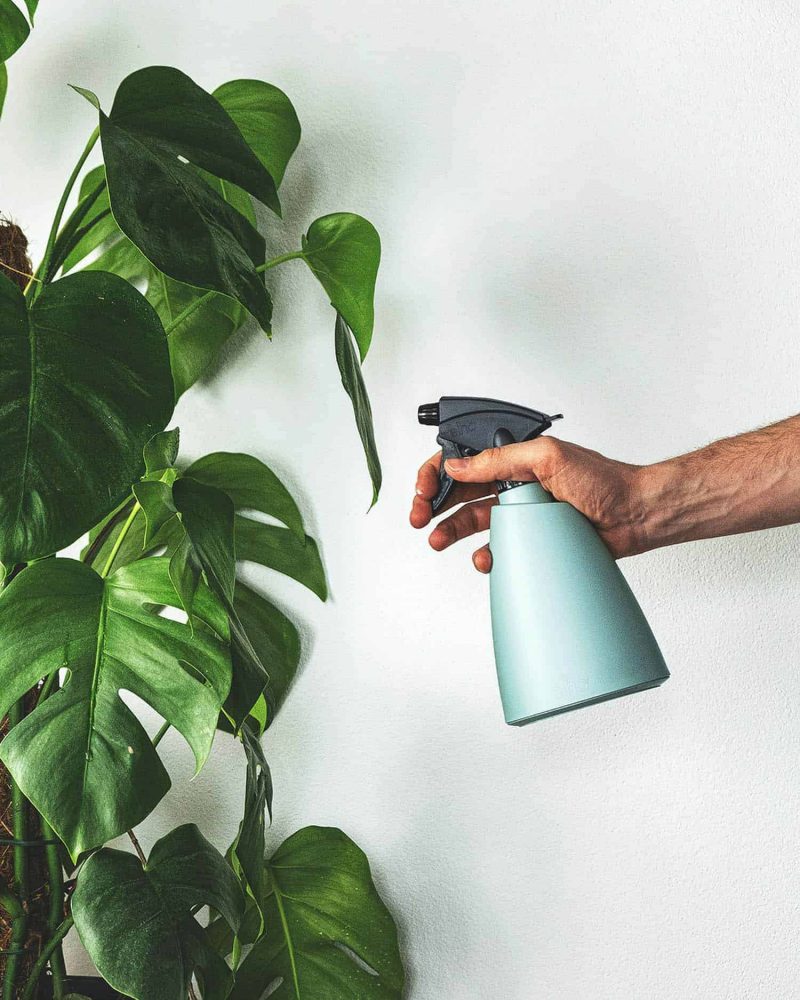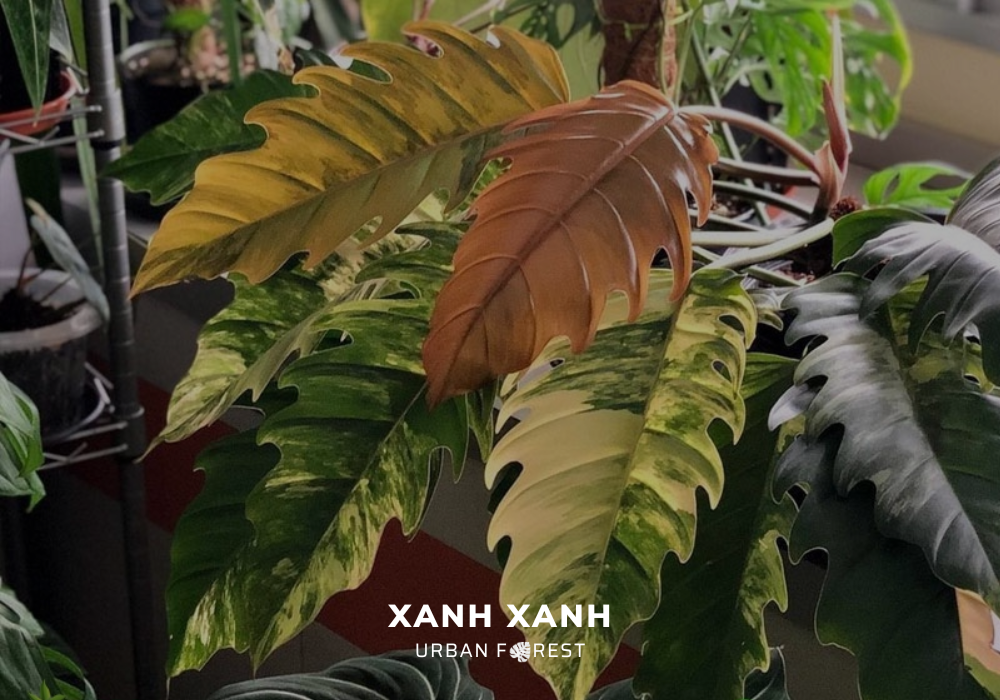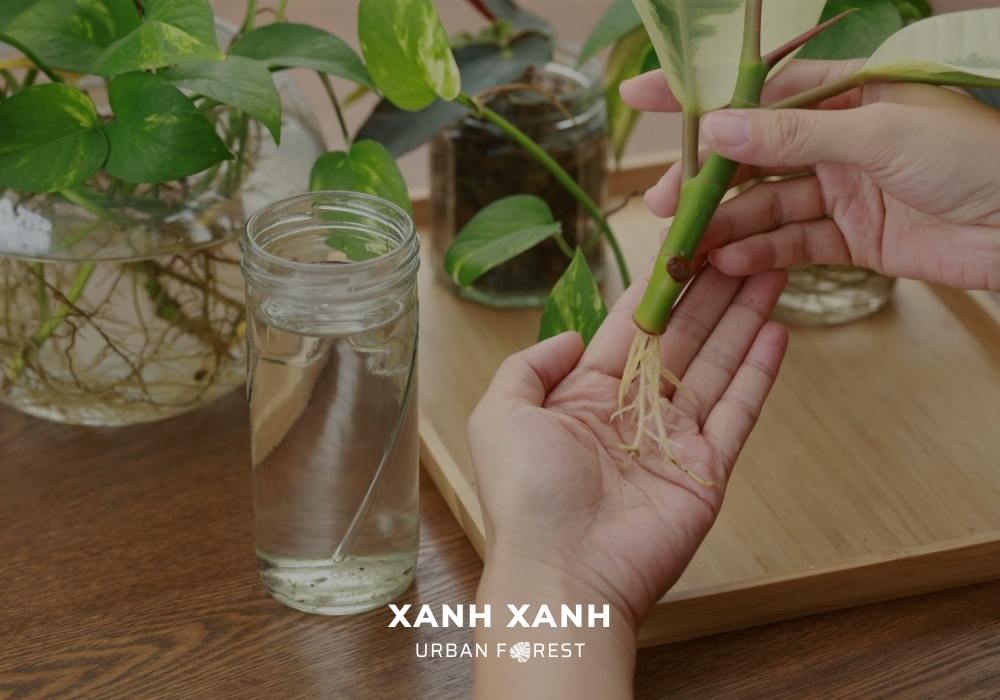Table of Contents
1. Introduction to Monstera
Monstera, with its iconic heart-shaped leaves, has taken the houseplant world by storm. While it’s known for its relative ease of care, there’s one key element crucial to its flourishing: humidity. In the blog, Xanh Xanh Urban Forest will delve into the ideal humidity range for Monstera, explore ways to create it, and discuss the consequences of both under and over-watering. Additionally, we’ll uncover other humidity-related diseases that can affect your beloved plant. So, let’s embark on a journey to ensure your plant thrives under your care!

2. Ideal Humidity and How to Create It
Monstera, native to the rainforests of Central and South America, thrives in an environment with high humidity, ideally between 60% and 80%. Maintaining this optimal humidity level is crucial for its healthy growth and vibrant foliage.
Here are some effective methods to create a humid haven for your plant:
- Grouping Plants: Placing your plant near other plants creates a microclimate with increased humidity due to transpiration, the natural release of water vapor through their leaves. This method is simple, natural, and aesthetically pleasing.
- Pebble Tray: Fill a tray with pebbles and water, ensuring the water level sits below the surface of the pebbles. Placing this plant pot on this tray allows the water to gradually evaporate, adding moisture to the surrounding air. This is a low-cost and easily maintained solution.
- Humidifier: Using a cool mist humidifier is an effective and convenient way to directly increase the humidity level in a room. Choose a cool mist humidifier and avoid placing it directly next to your Monstera to prevent waterlogging the soil. This method can be a good option for large spaces or during dry seasons.
- Bathroom Sanctuary: Bathrooms naturally have high humidity levels due to showering and bathing. Consider placing your Monstera in the bathroom, ensuring it receives adequate indirect light for optimal growth.
- Misting: While misting can provide temporary relief, it’s not a sustainable solution for maintaining optimal humidity. It can also promote fungal diseases if the leaves remain wet for extended periods.

Remember, maintaining proper humidity is just one aspect of caring for your Monstera. It also requires adequate light, proper watering, and an optimal temperature to flourish. By providing your Monstera with the ideal environment, you can witness its stunning growth and enjoy its vibrant foliage for years to come.
3. What Happens if Monstera is Too Moist?
Monstera, with its lush foliage, thrives in humid environments. However, too much moisture can be detrimental to its health, leading to root rot and other problems. Identifying the signs of excess moisture is crucial to taking timely corrective action and salvaging your beloved plant.
Signs of Excessive Moistness:
- Drooping leaves: Loss of turgidity in the leaves, resulting in drooping stems and a wilted appearance, is another telltale sign of excessive moisture.
- Mushy roots: Upon examining the roots, you might notice they appear mushy, brown, or black instead of firm and white. This confirms the presence of root rot.
- Foul odor: A faint, unpleasant smell emanating from the soil can sometimes indicate decaying roots and fungal growth.

If your plant exhibits any of the signs listed above, follow these procedures:
- Reduce watering: The first and most important step is to drastically reduce watering frequency. Allow the soil to dry out completely between waterings, ensuring the roots have access to oxygen.
- Improve drainage: If the pot lacks drainage holes or utilizes a poorly draining soil mix, consider repotting your Monstera into a pot with adequate drainage and a well-draining potting mix specifically designed for aroids.
- Increase air circulation: Good air circulation helps prevent moisture buildup and promotes faster drying of the soil. Position your Monstera near a window or use a fan to gently circulate air.
- Remove infected parts: If root rot is confirmed, carefully remove any infected leaves and stems to prevent further spread. Disinfect your pruning tools between each cut to avoid cross-contamination.
- Treat with fungicide: If root rot is severe, applying a fungicide specifically designed for houseplants can help control the fungal infection.
4. What Happens if Monstera is Too Dry?
Insufficient humidity can severely impact your Monstera’s health, leading to various issues and ultimately hindering its growth. Here’s a detailed breakdown of the consequences of low humidity and potential solutions to restore its health:
Signs of low humidity:
- Brown or yellow leaves: This is the most common symptom of low humidity. As moisture levels decline, the plant’s leaves lose their natural turgor, becoming dry and brittle. The edges and tips are particularly susceptible, turning brown and eventually breaking off.
- Slow or stunted growth: When deprived of adequate moisture, your Monstera’s growth slows down or completely stalls. It may not produce new leaves or develop aerial roots, which are crucial for climbing and aerial support.
- Increased susceptibility to pests and diseases: Dry conditions can weaken your Monstera’s defenses, making it more susceptible to infestations by spider mites, mealybugs, and other pests. Additionally, fungal diseases like powdery mildew and leaf spot thrive in dry environments, further jeopardizing the plant’s health.
Solutions:
- Increase humidity: Implementing various methods to increase humidity levels around your Monstera is crucial. This includes using a humidifier, misting the plant regularly (especially during dry seasons), grouping it with other humidity-loving plants, or placing it on a pebble tray filled with water.
- Adjust watering: While overwatering can be detrimental, underwatering is equally damaging during periods of low humidity. Ensure the soil feels slightly moist to the touch before watering and adjust the frequency based on the season and room temperature.
- Protect from direct sun: While Monstera prefers bright indirect light, prolonged exposure to direct sunlight can intensify the effects of low humidity. Consider relocating your plant or using sheer curtains to filter the sunlight.
By implementing these solutions and maintaining vigilant care, you can help your Monstera thrive even in environments with low humidity. Remember, a healthy Monstera will reward you with vibrant foliage and its unique, captivating beauty.
5. Other Diseases Related to Humidity
While proper humidity levels are crucial for Monstera’s well-being, excessive moisture can invite a host of unwelcome guests in the form of various fungal diseases. Here, we delve deeper into these threats and explore effective treatment options.
- Powdery Mildew: This common fungal disease manifests as a white, powdery coating on the leaves and stems of your Monstera. It thrives in humid environments with poor air circulation, causing stunted growth and yellowing leaves.
- Leaf spot: This umbrella term encompasses several fungal diseases that present as brown or black spots on the leaves. These spots may enlarge and merge, leading to leaf distortion and even defoliation in severe cases.
- Rust: This fungal disease reveals its presence through orange or brown, raised pustules on the leaves. Eventually, these pustules rupture and release spores that can quickly spread to other parts of the plant. Untreated rust can lead to premature leaf drop and weaken the overall health of your Monstera.
Early detection is key to effectively managing these diseases. Regularly inspect your Monstera for signs of disease infection, and take immediate action if you notice any suspicious symptoms. Remember, prevention is always the best medicine, so maintaining proper humidity levels and providing good air circulation are essential for keeping your Monstera happy and disease-free.
6. Final thoughts
Humidity is an important factor for the health of many plants, including Monstera. By providing the right amount of humidity, you can help your plant thrive. Xanh Xanh Urban Forest hopes that you found this blog article to be useful and educational. Please use the following to contact us with any questions:







Pingback: Brown Leaves on Monstera: Diagnosis and Care
Pingback: Black Leaves on Monstera: Causes and Fixes